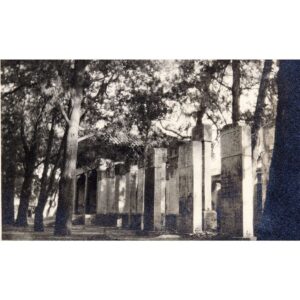Photography Ammunition Depot and Driveway to the Fort in the Austro-Hungarian Legation
A black-and-white photograph showing the ammunition depot and the driveway to the fort of the Viennese legation in the Legation Quarter in Beijing (Dongjiaominxiang 東交民巷). The latter was situated between 1861 and 1959 in the area of the Inner City (Neicheng 内城), east of present-day Tiananmen Square (Tiananmen Guangchang 天安門廣場), and south of the Forbidden City (Gugong 故宫 or Zijincheng 紫禁城).
In 1869, Austria-Hungary also signed a trade agreement with the Beijing court that was unfavourable to China. Soon after, the Viennese court opened its representative office in Beijing in a small mansion that became the embassy in 1896. The reconstruction of the embassy building, which was severely damaged during the Boxer Rebellion, was led by Slovenian-born architect Ivan John Jager (1871–1959). Austria-Hungary received a concession as a result of its involvement in the suppression of the uprising in the city of Tianjin during the Boxer Rebellion in 1902.
The ... more
A black-and-white photograph showing the ammunition depot and the driveway to the fort of the Viennese legation in the Legation Quarter in Beijing (Dongjiaominxiang 東交民巷). The latter was situated between 1861 and 1959 in the area of the Inner City (Neicheng 内城), east of present-day Tiananmen Square (Tiananmen Guangchang 天安門廣場), and south of the Forbidden City (Gugong 故宫 or Zijincheng 紫禁城).
In 1869, Austria-Hungary also signed a trade agreement with the Beijing court that was unfavourable to China. Soon after, the Viennese court opened its representative office in Beijing in a small mansion that became the embassy in 1896. The reconstruction of the embassy building, which was severely damaged during the Boxer Rebellion, was led by Slovenian-born architect Ivan John Jager (1871–1959). Austria-Hungary received a concession as a result of its involvement in the suppression of the uprising in the city of Tianjin during the Boxer Rebellion in 1902.
The photograph is the 21st of 449 photographs of Beijing and its surroundings in the album of Ivan Skušek Jr., purchased during his stay in Beijing (1914–1920). In the handwritten inventory of the album, the photograph is referred to as Oest. eng. Gesandtschaft: Munitionskammer und Auffahrt zum Fort (DZ)





































Do you have a comment or additional information about the subject?